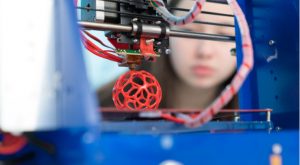The more descriptive moniker for this technology is additive manufacturing, seeing as it’s the opposite of traditional, subtractive manufacturing that involves cutting away material to achieve a final product.
More companies are now going for 3D printing because it allows them to create more intricate designs that are hard or impossible to achieve with traditional manufacturing.
The 3D printing industry is projected to expand dramatically over the next few years. Projections indicate it could reach almost $45 billion worldwide by 2027, according to a report by Hubs.
Here are 3D printing stocks with some of the most promising industrial applications.
Autodesk (ADSK)

Autodesk (NASDAQ:ADSK) is a computer-aided design (CAD) software maker. The San Francisco, California-based company’s solutions are used by companies in the construction, engineering and manufacturing fields, but also those in media and automotive. It has a flagship product, AutoCAD, which businesses can use to create detailed 2D and 3D designs cheaper and faster.
Autodesk has worked with some of the biggest names on the planet. Iconic landmarks and companies like the World Trade Center and Tesla (NASDAQ:TSLA) are just some of them.
The firm has what it calls Autodesk Fusion — a 3D printing software that supports businesses in the healthcare, aerospace and architecture industries.
In healthcare, for example, it can design accurate, custom prosthetics for patients. And, in aerospace, Fusion can help create lightweight components for airplanes to address the increasing need for better fuel efficiency and lower emissions.
Another promising application of Autodesk’s 3D printing is prototyping. Manufacturing companies use prototyping, creating physical samples of a new product to test and improve them to ensure the final product meets quality standards.
These use cases make Autodesk one of the most promising 3D printing stocks in the market.
Protolabs (PRLB)

Protolabs (NYSE:PRLB) started out by designing a software that sped up the production of injection-molded plastic prototypes. It later added CNC machining before rolling out a 3D printing service in 2014. Its business, which comprises hundreds of manufacturers under one umbrella, currently has over 120 3D printers and a client roster of over 50,000 customers under its belt, making it a strong pick for 3D printing stocks.
Though it serves several industries, it has honed down on aerospace, medical, consumer electronics and robotics and automation.
Aviation companies can get 3D-printed aerodynamic parts. Medical companies working on medical imaging devices and stem cell research can also order custom-made parts from the company.
Also, robotics companies get to work with highly effective robots and automated equipment. And electronics manufacturers can put together stylish features for audio, video and gaming.
HP (HPQ)

HP (NYSE:HPQ) has a stack of several 3D printers, including the HP Jet Fusion 5600 Series Industrial 3D Printing Solution and the S100 3D Printing Solution. The business helps companies in robotics, manufacturing, agriculture and housing design quality, 3D-printed parts to improve productivity and reduce costs.
Robotics companies can rethink how they design and build custom robotics and grippers. The result is strong parts that are lightweight and tailor-made to fit into the latest robotic systems.
Agriculture is another area where HP’s 3D printing is changing the game. For instance, John Deere (NYSE:DE) factories across the globe are deploying HP’s Metal Jet technology to produce thousands of tools, jigs and fixtures faster than before.
Those are just some of the industrial applications for HP’s 3D printing tech. As the industry continues to mature, it’ll continue to be one of the most exciting 3D printing stocks to watch.
On the date of publication, Hope Mutie did not have (either directly or indirectly) any positions in the stocks mentioned in this article. The opinions expressed in this article are those of the writer, subject to InvestorPlace.com’s Publishing Guidelines.
On the date of publication, the responsible editor did not have (either directly or indirectly) any positions in the securities mentioned in this article.
Hope Mutie is a writer who’s enthusiastic about finance and crypto. At InvestorPlace, she keeps her finger on the pulse of the stock and crypto markets to create insightful and info-rich content to help investors navigate the market with confidence.
